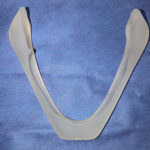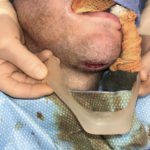A custom jawline implant is the most effective method for enhancing the skeletal structure of the lower third of the face. By having a connected implant that wraps around the entire jawline with dimensions that are predetermined by a computer design process, the most effective aesthetic jaw augmentation is achieved.


This elastic deformation property of silicone jaw implants makes the surgery possible to be done, if the implant design is not excessive, as a single implant in a front to back insertion process. The size of the jaw angles is the key as they usually have the largest bulk and must pass through the narrowest subperiosteal tunnel that connects the chin and the jaw angles pockets. To do so they are typically folded and passed under the mental nerve.
But when the the size of the jaw angles is larger, typically greater than 9mms of jaw angle width, it can not be folded and passed safely under the mental nerve. In this case the implant must be split in the midline and then placed in a ‘back to front’ technique. The smaller chin portion is safer to pass under the nerve. The implant is then reunited at the midline of the chin and fixed back together.
To be successful a custom jawline implant must have a good design as well as the design be able to successfully placed. This requires an innovative approach in some cases which may require the implant to be sectioned into two pieces and then reunited in situ back into a single implant.
Dr. Barry Eppley
Indianapolis, Indiana


